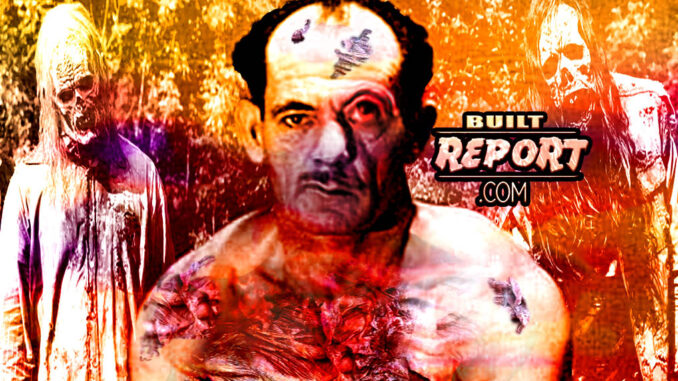
“Voodoo Swamp: A Forgotten Gem from the Depths of the Swamps”
In the early 1960s, the world of cinema bore witness to a remarkable and unusual endeavor, one that brought together the realms of bodybuilding and horror. The brain behind this unique cinematic creation was none other than Arthur Jones, the founder of Nautilus, and the central character of this intriguing tale was the renowned bodybuilder, Bill Pearl. The result of this collaboration was the low-budget horror film, “Voodoo Swamp,” a production that carved out its own niche in the annals of cinema history.
The Creative Mind Behind It All: Arthur Jones
Arthur Jones, the visionary inventor responsible for the revolutionary Nautilus exercise equipment, was not a stranger to innovation. His passion extended to various facets of life, and filmmaking was yet another arena where he aimed to make an impact. In 1962, Jones took on the roles of both writer and director for “Voodoo Swamp,” venturing into the world of storytelling with a passion akin to his pursuits in bodybuilding and engineering.
The Plot Unveiled: A Tale of Mystery and Intrigue
The storyline of “Voodoo Swamp” revolves around the character Mary Ryan, portrayed by the elegant Vicky. This central character, enigmatic and compelling, embarks on a relentless quest to find her missing twin sister, Vicky. Faced with the mysterious disappearance of her sibling, Mary delves into the depths of the enigmatic New Orleans swamps, seeking answers, and ultimately, her sister.
The Enigmatic Swamplands of New Orleans
The swamps of New Orleans, with their eerie and mystical aura, serve as the perfect backdrop for this suspenseful narrative. These lush, yet foreboding landscapes, shrouded in an air of the unknown, are brought to life on screen, casting a hypnotic spell on the viewers.
The Key Players: Bill Pearl and His Co-Stars
At the heart of “Voodoo Swamp” is the involvement of bodybuilder Bill Pearl. Bill Pearl’s involvement in the film marked a unique intersection of the world of bodybuilding and cinematic storytelling. A renowned figure in the bodybuilding world, Bill Pearl’s powerful physique and commanding presence translated effortlessly to the silver screen. His portrayal of detective Jack Craig brings a sense of intrigue and a dash of heroism to the film, as he becomes Mary’s steadfast ally in her quest.
Accompanying Bill Pearl in the film are notable co-stars such as David ‘Kit’ Beecher and Bill Binnings, each contributing to the unfolding drama with their own unique flair. Their interactions in the swamps of New Orleans are fraught with tension and uncertainty as they cross paths with the enigmatic voodoo priestess, Olivier, and her loyal, zombie-like henchman.
Unmasking the Mystical: Voodoo and Zombies
The film’s title, “Voodoo Swamp,” holds the promise of mystical elements intertwined with the enigmatic surroundings of the New Orleans swamps. Central to the story is the voodoo priestess Olivier, a character that embodies the mystique and power associated with voodoo practices. Her role adds a layer of intrigue, guiding the storyline through the lens of the mystical.
As the narrative unfolds, the protagonists, Mary and Jack Craig, come face to face with Olivier’s zombie henchman, adding an eerie and ominous dimension to their journey. The portrayal of these zombies invokes a sense of dread, their presence challenging the very boundaries between life and death.
Legacy and Resurgence
While “Voodoo Swamp” may have emerged as a unique and obscure creation in its time, the world of cinema has a penchant for rediscovering and celebrating such hidden gems. Today, it stands as a testament to the creativity and multi-faceted talents of Arthur Jones, a figure known primarily for his innovations in the world of fitness and bodybuilding.
This forgotten piece of cinematic history serves as a bridge between the realms of bodybuilding and horror, proving that unexpected collaborations can yield remarkable results. As the story of Mary, Jack Craig, and the voodoo priestess Olivier unfolds in the mystical swamps of New Orleans, “Voodoo Swamp” remains an intriguing chapter in the colorful tapestry of film history.
For those curious about this cinematic curiosity or drawn to the fusion of bodybuilding and horror, “Voodoo Swamp” offers a unique experience waiting to be unearthed and explored. In the world of cinema, hidden treasures often beckon to be discovered once more, inviting audiences to venture into the mysterious world of “Voodoo Swamp.”
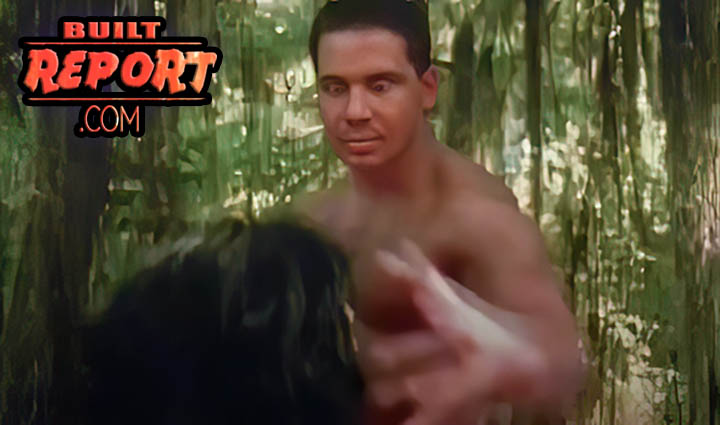
“Voodoo Swamp” – An Ominous Enigma of Cinematic Atrocity
In the expansive annals of cinema, there exist those films that defy the conventional trajectory of filmmaking. “Voodoo Swamp” is one such aberration, a peculiar cinematic creation whose origins remain shrouded in obscurity. Emerging from the abyss of forgotten movies, “Voodoo Swamp” made its enigmatic debut as a concealed bonus feature in 2003, accompanying “Blood of the Zombie” (also known as “The Dead One”). With an inexplicable narrative set in the mystic city of New Orleans, this film serves as a testament to the strange and unexpected side of cinema.
The Lost Opus: “Voodoo Swamp” Emerges
Before its covert resurrection in 2003, “Voodoo Swamp” lingered in the shadows, shunning traditional theatrical releases and evading the spotlight of home video distribution. A clandestine entity within the world of cinema, this film remained enigmatic for years, awaiting its opportunity to perplex and bewilder unsuspecting audiences.
Journey into the Unknown: The Plot of “Voodoo Swamp”
Set amidst the entrancing backdrop of New Orleans, “Voodoo Swamp” weaves a tale of suspense, dark mysticism, and supernatural horror. The story takes flight as a woman ventures into the heart of New Orleans in search of her missing sister, who has mysteriously disappeared. Laden with concern and fear, she recruits the services of a private detective, embarking on a quest to unravel the enigma of her sister’s vanishing. Their journey leads them to the eerie, otherworldly swamplands of New Orleans, where they encounter the arcane world of voodoo, replete with a menacing zombie portrayed by the legendary five-time Mr. Universe, Bill Pearl.
The Enigmatic Maestro: Arthur Jones and the Creation of “Voodoo Swamp”
While “Voodoo Swamp” is no exception to the realm of bizarre cinema, it does have an elusive creator to its name—Arthur Jones. Arthur Jones, whose legacy had primarily been associated with the world of bodybuilding, unexpectedly emerges as the mind behind this enigmatic film. An individual whose cinematic endeavors had largely remained obscure, Jones etches his name into the history of curious cinema with “Voodoo Swamp.”
A Shoestring Spectacle: The Budget and Production Values
A discerning observer would swiftly surmise that “Voodoo Swamp” was a project of meager means. The limited budget is conspicuous throughout the film, as evidenced by its production values. With little financial support to bolster its creative endeavors, “Voodoo Swamp” stands as one of the most economically challenged cinematic productions in history.
An Unfinished Tapestry: Gaps and Technical Imperfections
The enigma of “Voodoo Swamp” is compounded by its striking incompleteness, made apparent by the absence of opening or closing titles, leaving viewers to piece together the film’s enigmatic narrative. Technical issues further plague the production, with sound effects that rank among the most lackluster in cinematic history. Evident inadequacies in visual effects become apparent, epitomized by a scene featuring the protagonists splashing through water in silence. Dubbing anomalies add to the tapestry of technical imperfection, plunging the viewer deeper into a world of cinematic obscurity.
The Torment of Tedium: Pacing and Editing Woes
“Voodoo Swamp” is a film tormented by an excruciatingly sluggish pace. Its 70-minute runtime seems to stretch for an eternity, dragging viewers through the mire of a plodding storyline. Editing blunders plague the film, manifesting as a perplexing phenomenon in which remnants of prior scenes linger as new sequences emerge. The incorporation of stock footage featuring snakes and alligators further compounds the film’s woes.
A Cinematic Catastrophe: “Voodoo Swamp” as a Masterpiece of Atrocity
In the annals of cinema, a broad spectrum of films exists, from revered classics to hidden gems. “Voodoo Swamp” defies such categorization, emerging as a cinematic catastrophe, a masterpiece of atrocity that resounds with the echoes of ineptitude. Its lackluster production values, laborious pacing, technical imperfections, and bewildering editing choices coalesce to form a work of cinema that stands as a testament to the bewildering nature of the medium.
While “Voodoo Swamp” may never earn accolades for its cinematic excellence, it holds a peculiar position in the world of film—a forgotten enigma awaiting rediscovery. Those with a taste for the strange and the unexpected in cinema will find “Voodoo Swamp” to be a curious relic, a testament to the idiosyncrasies that occasionally emerge from the world of film.
Bill Pearl on Arthur Jones
“It’s impossible to overlook this opportunity to give you more insight on the Arthur Jones I know. He is, by far, one of the most unique individuals I’ve ever met. Mike Mentzer (former IFBB Mr. America winner) attempted to describe Arthur by stating, “Arthur Jones is not a relaxing person to be with. He does not lightly exchange words. He spews facts, torrents of them, gleaned from studies and perhaps more important, from practical application of theory, personal observations and incisive deduction. You don’t converse with Arthur Jones: you attend his lectures. He is opinionated, challenging, intense and blunt.”
I am in total agreement with Mike. This is just a taste of our on-again/off-again relationship, which began in 1958. Early one Monday morning, while I was opening the door to my Sacramento gym, Arthur appeared out of nowhere. He was wearing khaki pants, a khaki shirt and jacket that half-covered a .357 Magnum pistol strapped to his belt.
In his heavily southern accented, no-nonsense, baritone voice, he began the introduction, “You’re Bill Pearl. My name is Arthur Jones. I’m from Slidell, Louisiana. I’ve come to see if you’re interested in participating in a ‘gawd’-damn movie I’m going to produce. I’ll need you for about a month. It’s going to be filmed in Florida and Louisiana.”
I asked, “Do you make movies for a living?” He articulated every word with a slight pause in between to make sure that he wouldn’t have to repeat himself, “Hell, no. I have a large wildlife game reserve in Slidell that supplies most of the animal parks and zoos throughout the country with reptiles, exotic birds, monkeys and other ‘gawd’-damn wildlife that I capture in South America. But I’m not new to the film business. I’ve made several documentaries.” “When do you plan to start filming?” I asked. “As soon as I can get your ass down to Louisiana.” “What am I supposed to do in this movie?” “Whatever it takes to make the ‘gawd’-damn thing sell!” “How much are you willing to pay?” “How much are you worth?” We agreed on a price and, to this day, I’ve never picked up a tab when we’ve been together. His pride seemed offended whenever I’ve tried.
During those few days in Sacramento, it became obvious that we were from different worlds. Arthur had a definite opinion on everything. When it came to bodybuilding, he was convinced that the fastest muscular gains came from doing, “One set per muscle group–three days per week–while training to failure.”
On politics, I asked, “Do you think John F. Kennedy will become the next President of the United States?” His reply, “It really doesn’t matter. Some right-thinking Texan will take care of the son-of-a-bitch.”
Our differences became more obvious during the filming of his movie Voodoo Swamp. Arthur could survive on Coca-Cola and cigarettes while holding court with whomever until the wee hours of the morning, and then expect everyone to be ready to go at his beck and call. I needed food, rest and consistency.
We clashed about a week into the filming. Six of us were jammed in his new Oldsmobile station wagon traveling to shoot a scene that had me trudging up to my neck in swamp water filled with leeches. The car radio was tuned to a country station blaring so loud it was impossible to think. He made matters worse by chain smoking in the closed vehicle. I was dragging from lack of sleep, and a white bread bologna sandwich wasn’t my idea of a balanced diet.
Things came to a head when he began playing ‘grab-ass’ with the script girl sitting between us. I sat thinking, “This is ridiculous.” I flicked off the radio and shouted, “Stop the car!” Arthur retaliated with, “Why? You got a ‘gawd’-damn problem?” I shouted, “I’ve got several problems! First, I can’t breathe! Second, I don’t do well on bologna sandwiches! Third, I’ve had as much sleep this past week, as I normally get in a night. Now you two decide to start screwing around. Either there are some drastic changes, or I’m out of here!” He apologized by saying something like, “I didn’t realize you were so ‘gawd’-damn sensitive.”
The more violent side of Arthur erupted while we were shooting a night scene that had me throwing a stunt man off a bridge into a large pool of water. We had done the scene several times, which always ended in a big splash, but on the final take, there was a thud. The stunt man had landed on the bank rather than in the water. With a loud moan he cried, “Arthur–if we’re going to do this again, make sure Mr. Pearl tosses me further to the left!”
A carload of teenage boys had stopped to watch the filming. As they drove away, a crew member called out that he was missing an expensive camera. He was insistent that the teenagers had taken it.
In less than a block, they were pulled over. Arthur ran to their car screaming, “Did one of you steal my ‘gawd’-damn camera?” There was no response. Arthur pulled out his pistol, drew back the hammer, placed the barrel in the middle of the driver’s forehead saying, “Boy, I’m going to ask you one more time, before I scatter your ‘gawd’-damn brains all over this car! Did one of you steal my ‘gawd’-damn camera?” His reputation must have preceded him. The driver stuttered, “Honest Mr. Jones, we did not ta–ta–take your camera.” Not satisfied, Arthur told me to begin searching the car. Fortunately, one of his crew ran up screaming that they had found it stored in the back of the station wagon. It seemed everyone but Arthur let out a sigh, as he eased back the hammer of the gun.
In our final days of filming, Arthur had rented a beautiful old mansion on the outskirts of New Orleans. I was to be kept imprisoned in the mansion while recovering from the lady witch doctor’s spell. They had me tied to beds, chairs, or whatever, to prevent me from causing more harm. Arthur had left instructions for Shorty, the head cameraman, to shoot a scene in the enormous living room where I was tied between two large pillars.
Shorty, like Arthur, was a chain smoker. He had a bad habit of setting lighted cigarettes on everything, which began to take its toll on the beautiful antique furnishings. What upset me even more was that he’d drop the butts on the marble floors, and then grind them out with the soles of his shoes. I finally told him, “Shorty, you do that one more time, and I’m going to bounce you on your can.” Sure enough, the next cigarette out of his mouth went on the floor to be ground to death. I jerked out of the ties and hit him so hard it knocked him, the camera, the tripod, the lights and canisters of film onto the floor.
Arthur heard the commotion and ran into the room shouting, “What-n-the-‘gawd’-damn-hell’s going on here?” Shorty looked up, saying, “He just hit me, and I bet he broke the camera.” Arthur asked, “Why in the hell did you do that?” I replied, “Because he has destroyed half of the antique furniture in this house with his lousy cigarettes and is now doing the same to the marble floors. It’s going to cost you more money for repairs, than you’ll make from the movie.” Arthur looked at Shorty and said something like, “You stupid moron. I should blow your ‘gawd’-damn brains out.” I returned to Sacramento without ever seeing the finished version of the movie.
Several months later, Arthur invited me to view his latest film that he shot and produced in Africa. The screening took place in a private Hollywood studio. I had no idea what to expect, but knew it would not be a sequel to the movie Lassie. The least violent part of the two-hour documentary was the opening scene. It showed several natives dragging an enormous crocodile from a lake. The natives were close to losing limbs, as they struggled to get the crocodile subdued and turned over on its back, before Arthur stepped in with a huge knife to slit open its belly to pull out a young boy.”
“After another lapse of time, Arthur phoned from the Los Angeles International Airport asking if he could stay with me for a few days. I had moved from Sacramentoto Los Angeles and was living close to the airport in the apartment above the Manchester Gym with a spare bedroom–so–“Sure!” He was back to supplying animal parks and zoos with reptiles, exotic birds, monkeys and other ‘gawd’-damn wildlife. He was headed for the Galapagos Islands, located six hundred fifty miles west of Ecuador.
After keeping me up most of the night, he went to a corner cafe the following morning for coffee. I walked into the spare bedroom to find several large stacks of one hundred dollar bills lying on the bed, which had not been slept in. The apartment had been broken into a couple of weeks before, which caused me more than a little anxiety seeing somewhere between $35,000.00 and $50,000.00 in cash lying out in plain view. When Arthur returned, I suggested that he find a better place for his money. Later, I asked, “Why are you carrying so much cash?” His answer, “Money talks, especially American money.”
Weeks went by before another phone call from Arthur, which originated from the Los Angeles International Airport’s freight depot. Offering no explanation, Arthur barked, “Bill, this is a matter of life and death! I want you to immediately go to the produce mart in Los Angeles. Pick up five-hundred pounds of ‘gawd’-damn bananas! Bring them to the United Air Lines freight depot as quickly as possible.” (The telephone went click.)
I was at the produce mart in twenty minutes. I found an outdoor fruit stand and didn’t bother shopping prices or explaining why I was buying five-hundred pounds of “’gawd’-damned bananas;” I didn’t know myself.
The United Air Lines freight depot’s loading dock was filled with crates of exotic birds. Arthur was running around screaming, “The ‘gawd’-damn things are going to die if they don’t get food and water. You continue filling the water dishes, I’ll do the rest.”
He eventually calmed down, but insisted he had to travel in the cargo hold of the airplane to be sure the birds were fed and watered on their trip to Slidell. He was told to go the United Air Lines main terminal to obtain permission.
Standing next in line at the ticket counter, I watched Arthur get a pained look on his face while, through clenched teeth he screamed, “My ‘gawd’-damn hemorrhoids are killing me.” The female ticket agent and everyone close by gasped as he loosened his pants and jammed his right hand down the back of his shorts to take care of the problem. Squaring himself away before stepping up to the counter, he offered the agent his tickets with the hand that had just performed the miracle. She bellowed out, “I can’t take this! I’m calling my supervisor!” He looked at me, saying, “What the ‘gawd’-damn hell’s wrong with her?”
“Arthur founded Nautilus Sports/Medical Industries, in 1970. His new line of exercise machines became so popular over the next ten years, it was said that more money was spent on Nautilus than on all other commercial gym equipment being sold.
The first version of his machine was previewed in Culver City, California, at that year’s AAU Mr. America Contest. I acted as Master of Ceremonies. My training partner, Chris Dickerson, became the first Afro-American to win the title.
Arthur had transported the prototype from Slidell, to Culver City, in a rented trailer. To save money, he stayed at our home in Pasadena. His 13-year-old son, Gary, remarked with confidence, “We can put another inch on your arm in a month, if you will use the machine.”
The Nautilus multi-station unit that sat in the lobby of the Culver City convention hall looked like a bad substitute for the popular Universal multi-station unit. Arthur’s unit was cumbersome, poorly built, painted blue and equipped with lever arms to hold free-weights. It was immediately nicknamed “The Blue Monster.” Its best selling points were Arthur’s gift-of-gab and the off-centered cams, which were pitched to everyone who would listen.
I later commented to Arthur that trying to compete against the Universal multi-station unit might be a mistake. I suggested that he design separate pieces of equipment incorporating the off-centered cam and then promote his theory of training, which could only be done “on his machines.” How much influence my suggestion had on his decision to do this is anyone’s guess, but that’s what eventually evolved.
At the beginning of the Nautilus reign, Arthur used the editorial pages of Iron Man Magazine to promote his concepts. Issue after issue was filled with his opinions on training. The magazine was so hard-core, its readers were more than willing to give Arthur’s theories a try, if they could get their hands on his equipment. Sales of his units were going out of sight. Prospective buyers were phoning my gym day and night to confirm what Arthur was preaching. There were so many calls, in fact, that it started interfering with my ability to run my business. He convinced me that my time wasn’t being wasted. In exchange, he was going to give me the new Nautilus Biceps/Triceps and Torso Pullover machines, plus an exclusive written Nautilus franchise for the State of California.
He then tried to convince me that bodybuilding had changed since my last competition in 1967. The only way I could win the 1971 NABBA Professional contest was by following his training principles, along with incorporating the Nautilus machines into my programs. It mattered little that I’d done quite well with free weights for twenty-five years. When the Biceps/Triceps and Torso Pullover machines arrived, I placed them in the living room of our home for my own personal use. Later, to Judy’s relief, they were transferred to the gym, where they became so popular it was nearly impossible to get near them.
Our relationship became more strained when I informed Arthur that I had replaced the lever arms of my Nautilus machines in the Pasadena Health Club with weight stacks. Arthur went ballistic saying, “You ruined the ‘gawd’-damn biomechanics by doing that.” My reply was, “Arthur, you’re wrong. The movement is even better. Because of the weight stacks you now start the motion from a dead stop rather than having a swinging motion. Besides, there are no weight plates to pick up, the machines are more simple, safer and faster to use.” “Yah… but… but,” he sputtered. Later it occurred to me that Arthur might not have been so upset because I ruined the ‘gawd’-damn biomechanics of his machines, as he was with the fact that he was now going to have to add weight stacks to the machines he was currently manufacturing. It was possible that he didn’t have the capital to make the conversion at that time.
It came down to where I either had to replace the lever arms on my machines, or he was going to renege on the exclusive Nautilus franchise for California. Stupidly, I told him it would be a relief to get back to running my gym. That remark probably cost me millions of dollars from the profits of the sales of Nautilus in the State of California, over the next several years.
Matters didn’t improve when I publicly questioned Arthur’s theories regarding the advantages that came from training on the Nautilus Isokinetic machines. Much of the promotional material in the early days of Nautilus was based on the claim that free weights were obsolete, injury-causing antiques. I disagreed. He claimed that three twenty-minute workouts per week on Nautilus equipment could produce a physique like mine. Again, I disagreed by stating, “Nobody who has trained exclusively on Nautilus has won a major physique contest.” This enraged Arthur to the extent that he began threatening Leo and me with phone taps and hit men. Why he included Leo is anyone’s guess.
He used Iron Man Magazine to wage his war, which became more venomous with each issue. The final straw occurred when he commented that it was “rumored” that my training partner, twenty-eight-year-old Willie Stedman, had died because of anabolic steroid use, which I supposedly had supplied. It was sadly true that Willy had died, but the cause of death was pneumonia, brought on by a lethal strain of Asian flu. I contacted Peary Rader, the owner and publisher of Iron Man Magazine, threatening a lawsuit if a retraction wasn’t printed.
I kept training for the 1971 NABBA Mr. Universe, using the same methods that had brought the best results in the past. By now, Arthur was so irate it was “rumored” that he had given Sergio Oliva $5,000.00 to come to Florida to train on Nautilus with a promise of another $5,000.00, if he won the contest.”

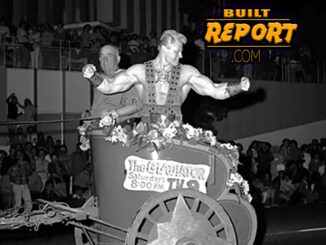
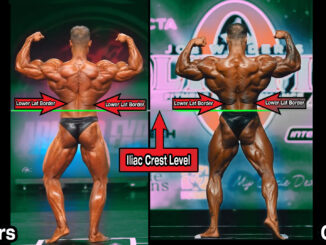
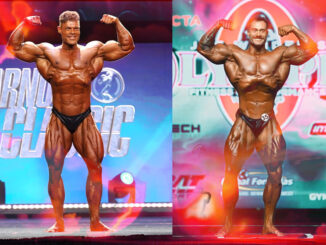
Be the first to comment